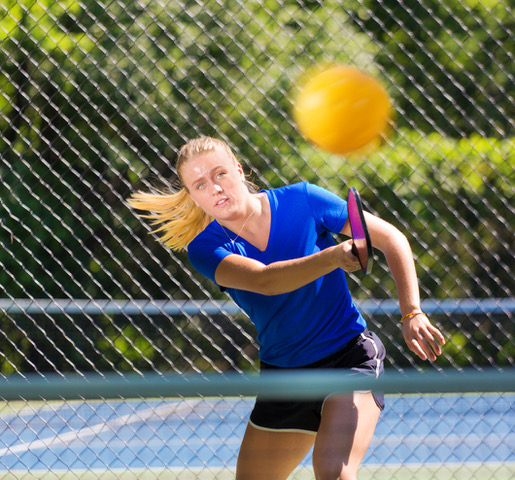Game & Skill Level
Georgia Pickleball
Skill Levels & Summaries
This player is just starting to play pickleball and has no other sports background. Minimal understanding of rules of the game.
This player has limited experience. Can sustain a short rally with players of equal ability. Basic ability to keep score.
- Forehand: Ability to hit a medium-paced shot. Lacks directional intent and consistency.
- Backhand: Avoids using a backhand. Lacks directional intent and consistency.
- Serve/Return: Able to hit a medium paced shot. Lacks depth, direction and consistency.
- Dink: Not able to consistently sustain a dink rally. Not yet developed the ability to control this shot
- 3rd Shot: Generally hits a medium-paced ball with little direction.
- Volley: Able to hit a medium-paced shot. Lacks direction/inconsistent
- Strategy: Understands fundamentals. Is learning proper court positioning. Knows the fundamental rules and can keep score and is now playing tournament.
- Forehand: Improved stroke development with moderate level of shot control.
- Backhand: Learning stroke form and starting to develop consistency but will avoid if possible.
- Serve/Return: Consistently gets serve/return in play with limited ability to control depth.
- Dink: Increased consistency, with limited ability to control height/depth. Sustains medium length rallies. Starting to understand variations of pace.
- 3rd Shot: Developing the drop shot in a way to get to the net.
- Volley: Is able to volley medium paced shots thereby developing control.
- Strategy: Moves quickly towards the non-volley zone (NVZ) when opportunity is there. Acknowledges difference between had game and soft game and is starting to vary own game during recreational and tournament play. Can sustain short rallies. Is learning proper court positioning. Basic knowledge of stacking and understands situations where it can be effective.
- Forehand: Consistently hits with depth and control. Is still perfecting shot selection and timing.
- Backhand: Has improved stroke mechanics and has moderate success at hitting a backhand consistently.
- Serve/Return: Places a high majority of serves/returns with varying depth and speed.
- Dink: Increased consistency with moderate ability to control height/depth. May end dink rally too soon due to lack of patience. Is beginning to understand difference between attackable balls and those that are not.
- 3rd. Shot: Selectively mixing up soft shots with power shots to create an advantage with inconsistent results.
- Volley: Able to volley a variety of shots at different speeds. Is developing consistency and control. Starting to understand the block/re-set volley.
- Strategy: Aware of partner’s position on the court and is able to move as a team. Demonstrates ability to change direction in an offensive manner. Demonstrates a broad knowledge of the rules of the game. Has a moderate number of unforced errors per game. Solid understanding of stacking and when and how it could be used in match play. Beginning to identify opponents weaknesses and attempts to formulate game plan to attack weaknesses. Beginning to seek out more competitive play.
- Forehand: High level of consistency. Uses pace and depth to generate opponents’ error or set up next shot.
- Backhand: Can effectively direct the ball with varying depth and paces with good consistency.
- Serve/Return: Serves with power, accuracy and depth, and can also vary the speed and spin of the serve.
- Dink: Ability to place ball with high success at changing shot types while playing both consistently and with offensive intent. Recognizes and attempts to hit attackable dinks.
- 3rd. Shot: Consistently executes effective 3rd shot strategies that are not easily returned for advantage. Able to intentionally and consistently place the ball.
- Volley: Able to block hard volleys directed at them and can consistently drop them into the NVZ. Comfortable hitting swinging volleys. Hits overhead shots consistently, often as put-aways.
- Strategy: Has good footwork and moves laterally, backward, and forward well. Uses weight transfer for more efficient footwork. Able to change direction with ease. Very comfortable playing at the non-volley zone (NVZ). Communicates and moves well with partner – easily “stacks” court positions. Understands strategy and can adjust style of play and game plan according to the opponent’s strengths and weaknesses and court position. Limited number of unforced errors.
- Forehand/Backhand/Serve/
Return: Hits all shot types at a high level of ability from both the forehand and backhand sides including: touch, spin, and pace with control to set up offensive situations. Has developed good touch from all court positions. Has developed a very high level of variety, depth and pace of serves. - Dink: Mastered the dink and drop shots. Ability to move opponents with shot placements. Exhibits patience during rallies with the ability to create an opportunity to attack utilizing the dink. Increased ability to change the pace of dinks strategically.
- 3rd Shot: Mastered the 3rd shot choices and strategies to create opportunities for winning points. Able to drop and drive ball from both the forehand and backhand side with high level of consistency.
- Volley: Able to block hard volleys directed at them and consistently drop them into the NVZ. Places overheads with ease for winners. Able to volley shots toward opponents feet consistently. Comfortable with swinging volley in both initiating and ability to attack back or neutralize return.
- Volley: Able to block hard volleys directed at them and consistently drop them into the NVZ. Places overheads with ease for winners. Able to volley shots toward opponents feet consistently. Comfortable with swinging volley in both initiating and ability to attack back or neutralize return.
- Strategy: Mastered pickleball strategies and can vary strategies and styles of play in competitive or tournament matches. Is successful at turning defensive shots into offensive shots. Has efficient footwork and effective use of weight transfer for improved quickness on the court. Easily and quickly adjusts style of play and game plan according to the opponent’s strengths and weaknesses and court position. Rarely makes unforced errors.
This player is a top caliber player. Performance and tournament wins speak for this player’s ability to consistently perform at a high level.

